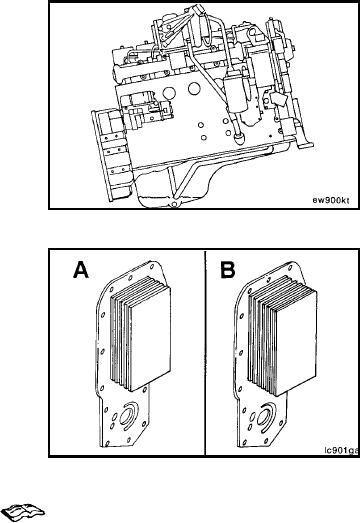
TM 5-2420-230-24-2
B3.9 and B5.9 Series Engines
Lubricating Oil System Diagnostics (007-048)
Section 7 - Lubricating Oil System - Group 07
Page 7-37
Low-lubricating oil level will not normally appear as low oil
pressure. Typically, it will appear as an intermittent loss of
oil pressure when rounding a corner or operating on a
steep grade. This condition exists when the oil level is
extremely low and the suction tube can not pick up oil
during all modes of operation.
Lubricating Oil Coolers
The engines use full-flow, plate-type oil coolers. The oil
flows through a cast passage in the cooler cover and
through the element where it is cooled by engine coolant
flowing past the plates of the element. The four-cylinder
engine uses an element with five plates (A); the six cylinder
uses an element with seven plates (B). Because of the
differences in plate restriction and oil pump capacities, the
oil cooler components are not interchangeable between
the four-cylinder and six-cylinder engines. The use of in-
correct components can cause high or low oil temperature,
varnish, and sludge buildup.
NOTE: Prior to October 10, 1986, six-cylinder engines were
assembled with nine-plate oil cooler elements.
Lubricating Oil Filter Bypass Valve
The lubricating oil cooler cover contains a bypass valve that
will let the lubricating oil flow bypass a plugged filter. The
valve is designed to open when the pressure drop across
the filter is more than 138 kPa [20 psi], as with a plugged
filter, and lets the lubricating oil continue on through the
engine. When a filter becomes plugged, an oil pressure
decrease of 60 kPa [9 psi] or less from the normal operating
pressure can be observed on the vehicle lubricating oil
pressure gauge. This allows unfiltered oil into the engine.
This condition should be avoided by changing the filter at
each oil drain interval as described in the Operation and
Maintenance Manual, B Series Engines, Bulletin No.
3810205.
L-1049

